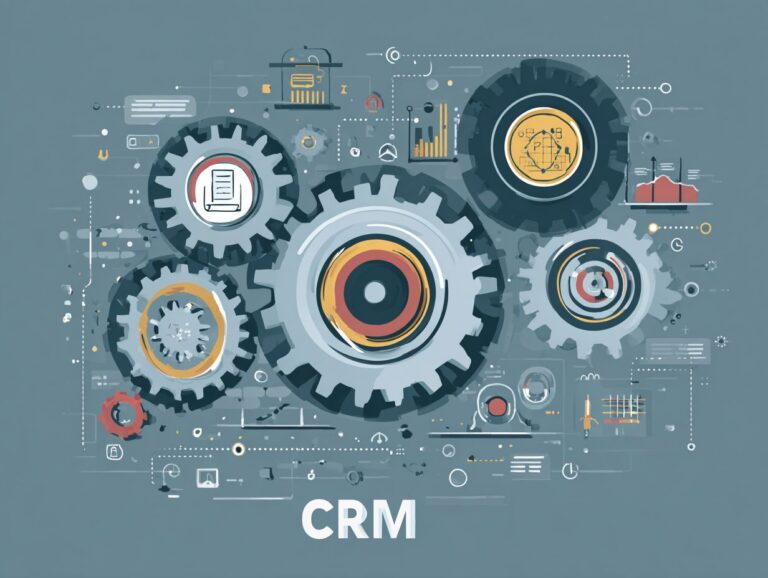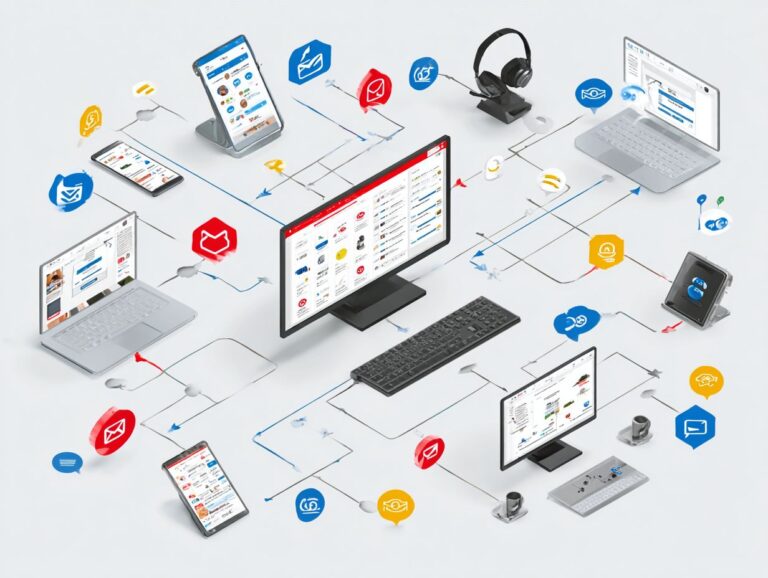CRM Enrichment: Definition, Benefits, Implementation Strategies
In the current market, improving CRM data is essential for having correct information and developing strong customer relationships. By adding detailed data to your CRM, companies can make informed choices that improve operations and increase marketing effectiveness.
This article discusses what CRM enrichment is, the many advantages it offers, and practical ways to put it into practice, giving you the knowledge required to improve your business. Get the most out of your CRM and change how you interact with customers!
Key Takeaways:
- Improving CRM involves updating customer data with more details to better understand customers and make sales work more effectively.
- Benefits of improving CRM include better data accuracy, more knowledge about customers, and higher sales productivity.
- Successful ways to improve CRM include using data sources and tools, and connecting with current systems.
Definition of CRM Enrichment

CRM enrichment involves improving customer data by adding more information and details to make it more accurate.
1. What is CRM Enrichment?
CRM enrichment involves adding more information such as age, location, and actions taken to show how customers act more clearly.
For instance, using demographic data from sources like Crunchbase can improve customer profiles by including details such as company size, industry, and funding information. This detail allows businesses to tailor targeted communications effectively.
Incorporating behavioral data from email interactions and social media engagement helps identify customer preferences and engagement levels. Tools like Clearbit and ZoomInfo can collect this information automatically, keeping your CRM current and useful, which allows for better marketing campaigns.
2. Types of CRM Enrichment
There are different ways to improve CRM systems, such as using external data providers like IBM and combining data from within the company to create detailed profiles of customers.
To improve your CRM, think about using third-party data integration. This can offer useful information from vendors like Optimo. This tool pulls in demographic and firmographic data, streamlining lead scoring and segmentation.
Look through your data to find any missing or wrong information. You can use tools such as Data Ladder to help tidy up and arrange your records. Use social media data to improve profiles. Tools like Hootsuite can monitor engagement numbers and audience details to keep your customer information current and useful.
Benefits of CRM Enrichment
Improving CRM methods can significantly increase data accuracy, giving a clearer view of customers and leading to more successful sales.
1. Improved Data Quality

Improving data quality through CRM updates can cut errors by up to 25%, leading to more accurate customer profiles for better communication.
To do this, think about using tools like D&B Hoovers. These can check and improve customer data, which results in better accuracy. For instance, a company utilizing D&B Hoovers experienced a 30% increase in lead conversion rates after enhancing their data quality.
Regular data cleansing with software such as Trifacta or Talend can help maintain data integrity over time. Reviewing your CRM data every three months can reduce mistakes, improve engagement plans, and increase sales.
2. Enhanced Customer Insights
Improving CRM data helps businesses better track customer behavior, enabling them to classify users more precisely and design targeted marketing campaigns.
For example, a retail company used detailed customer data from its CRM to study buying habits based on website activity and previous purchases. By segmenting customers into specific groups-like high-value shoppers and occasional buyers-they were able to tailor email marketing campaigns.
Shoppers who spend a lot received special offers, while those who buy less often got suggestions based on what they viewed. This approach increased email engagement rates by 30% and raised sales by 15%, showing how detailed information can lead to more effective marketing strategies.
3. Increased Sales Efficiency
By using improved data, companies can simplify their sales processes, leading to a 30% rise in converting leads.
For example, a technology SaaS company used CRM tools like Clearbit and ZoomInfo to improve their lead scoring process. By matching detailed customer information with their current CRM, they customized their sales presentations successfully, increasing engagement rates by 25%.
An online store increased upsells by 40% after using detailed data showing customers’ past purchases and likes. These strategies improved lead quality and built long-term relationships, greatly increasing sales productivity.
How to Improve Your CRM System
Here are some simple steps to make your CRM system work better:
- Connect Systems: Link your CRM with other tools you use, like marketing software or customer support platforms. This helps to keep all your information in one place.
- Employee Training: Make sure your team knows how to use the CRM effectively. Regular training sessions can help them make the most of the system.
- Adapt for Needs: Change the CRM to fit your business requirements. This might mean adding new fields, changing how it looks, or setting up automated processes.
- Update Regularly: Keep your CRM software current with the latest features and security updates. This helps it run efficiently.
- Clean Data: Regularly review and tidy up your data to remove duplicates and incorrect details. This keeps your database accurate and useful.
- Listen to Customers: Pay attention to what your customers say about your CRM. Use their feedback to make it better. By following these steps, you can make your CRM system more useful and beneficial for your business.
To improve CRM data, create a detailed plan that checks the sources of the information and how it integrates with your existing systems. For an extensive analysis of this integration, our comprehensive study on customer experience organizational structures discusses effective strategies.
1. Data Sources and Tools

Using data from both external providers and our own resources is important for improving CRM. Tools like Monday.com and Crunchbase are important in this process.
Along with Monday.com and Crunchbase, you might want to look at other important tools like D&B Hoovers, starting at $200/month for detailed business information, and ZoomInfo, which provides advanced contact data with plans that can vary widely. These platforms connect easily with your existing CRM, allowing you to include more detailed information.
Another useful way is to routinely check your internal CRM system to tidy up and refresh your database, ensuring all customer details are accurate and helpful. This method, along with external data tools, greatly improves your outreach efforts.
2. Integration with Existing Systems
Linking CRM tools with systems like Salesforce or HubSpot can improve data management and make processes more efficient.
To achieve this integration, consider using APIs for data flow between systems. For example, use Zapier to set up processes that automatically update customer information instantly.
A common issue is data mapping; make sure that fields like email and phone numbers match correctly between systems. Checking these connections thoroughly before using them completely is essential.
Consider using tools like Integromat for more complex workflows, allowing for greater customization while maintaining data integrity. Addressing these challenges early can lead to a more effective integration process.
Challenges in CRM Enrichment
While improving CRM systems has benefits, it also encounters issues such as duplicate information and maintaining data quality from various sources. Data redundancy occurs when duplicates proliferate across databases, leading to inconsistent information.
To combat this, employ tools like Dedupely or Insegment, which automatically identify and merge duplicate records. It’s important to verify your data. Use services like NeverBounce to maintain accurate and current email lists.
Establish protocols to regularly cleanse your data, ideally on a monthly basis, ensuring you remove incorrect or outdated entries.
By using these methods together, organizations can improve the trustworthiness and dependability of their CRM data.
Future Trends in CRM Enrichment
The development of CRM improvements will be influenced by trends in data privacy, automation, and the combination of detailed information into business systems.
To keep up with these changing trends, businesses need to use modern automation tools like HubSpot or Salesforce, which easily bring together data.
For example, using AI tools like Clearbit or ZoomInfo can improve lead quality by giving detailed customer profiles. As data privacy regulations like GDPR and CCPA tighten, organizations should prioritize compliance and transparency in their data sourcing strategies.
For those aiming to build their online reputation amidst these challenges, leveraging AI-enhanced customer feedback systems can be a crucial step. Learn how to effectively integrate these tools by exploring our insights on building your online reputation with AI-enhanced customer feedback.
Regularly updating privacy policies and training staff on ethical data usage is important for keeping customer trust and improving CRM data management.
Frequently Asked Questions
1. What is CRM Enrichment?
CRM Enrichment involves improving and refreshing customer information in a Customer Relationship Management (CRM) system. This means improving current data to provide a complete and accurate customer profile.
2. What are the benefits of improving CRM data?
CRM Enrichment provides many advantages, such as making customer data more accurate and complete, giving a more customized experience for customers, and allowing for better marketing and sales strategies.
3. How can CRM Enrichment be implemented?
CRM Enrichment can be done in different ways, like cleaning data, adding extra data, and combining data. It can also be done by entering data manually or using third-party services to improve data quality.
4. What are some main strategies for improving CRM data?
Some important strategies for effective CRM Enrichment include setting clear goals, frequently checking and updating customer information, applying data validation techniques, and using technology to simplify the process.
5. Is CRM Enrichment useful only for big companies?
No, improving CRM can help businesses of any size. Small businesses can gain advantages from keeping a tidy and correct database of customer details, leading to better marketing, sales, and customer retention.
6. How frequently should you update CRM Enrichment?
How often you update CRM information can change based on what the organization requires. It is a good idea to check and update customer data often, either every month, every three months, or every year. This helps make sure you have the most correct and current information for business tasks and making decisions.





